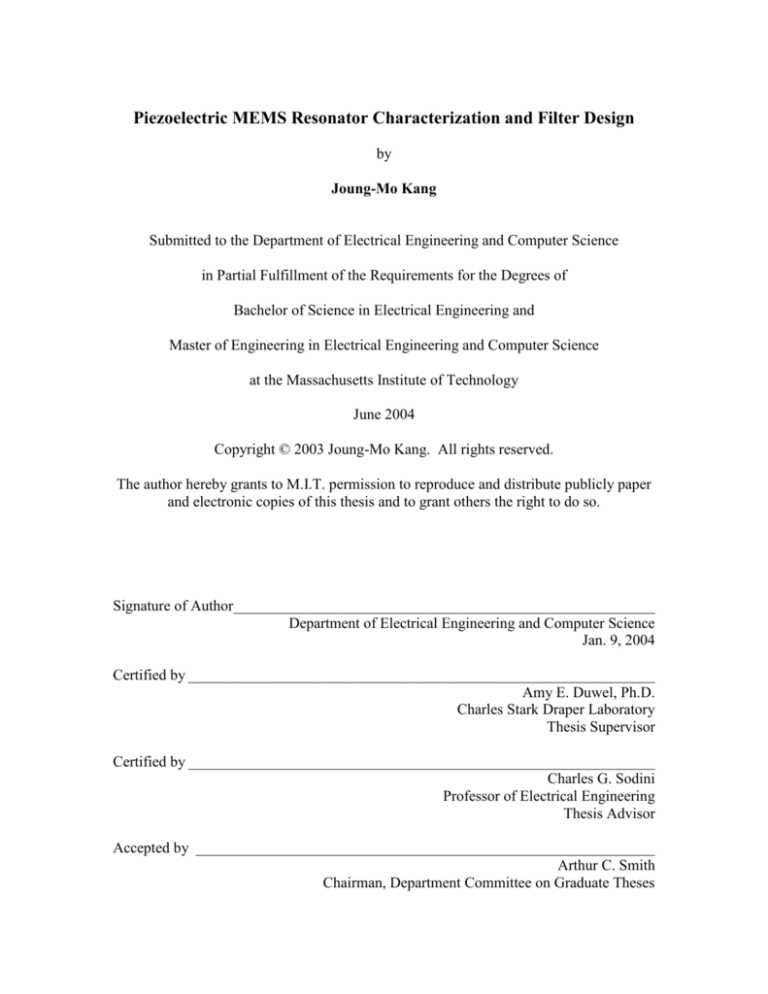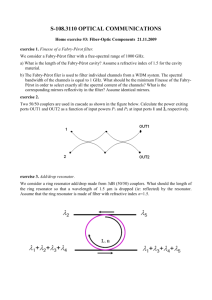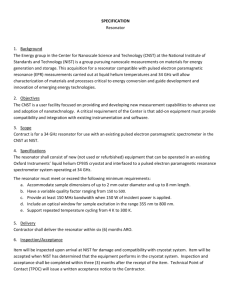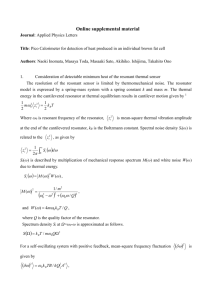
Piezoelectric MEMS Resonator Characterization and Filter Design
by
Joung-Mo Kang
Submitted to the Department of Electrical Engineering and Computer Science
in Partial Fulfillment of the Requirements for the Degrees of
Bachelor of Science in Electrical Engineering and
Master of Engineering in Electrical Engineering and Computer Science
at the Massachusetts Institute of Technology
June 2004
Copyright © 2003 Joung-Mo Kang. All rights reserved.
The author hereby grants to M.I.T. permission to reproduce and distribute publicly paper
and electronic copies of this thesis and to grant others the right to do so.
Signature of Author________________________________________________________
Department of Electrical Engineering and Computer Science
Jan. 9, 2004
Certified by ______________________________________________________________
Amy E. Duwel, Ph.D.
Charles Stark Draper Laboratory
Thesis Supervisor
Certified by ______________________________________________________________
Charles G. Sodini
Professor of Electrical Engineering
Thesis Advisor
Accepted by _____________________________________________________________
Arthur C. Smith
Chairman, Department Committee on Graduate Theses
[THIS PAGE INTENTIONALLY LEFT BLANK]
2
Piezoelectric MEMS Resonator Characterization and Filter Design
by
Joung-Mo Kang
Submitted to the Department of Electrical Engineering and Computer Science
on Jan. 16, 2004, in partial fulfillment of the requirements for the degrees of
Bachelor of Science in Electrical Engineering and
Master of Engineering in Electrical Engineering and Computer Science
Abstract
This thesis presents modeling and first measurements of a new piezoelectric MEMS
resonator developed at Draper Laboratory. In addition, some simple filter designs
incorporating the resonator with predicted performance parameters were analyzed, with a
special focus on the suitability of using the Draper resonator to implement these filters.
The four-element Butterworth Van-Dyke model, the traditional circuit model used to
describe crystal resonators, was predicted to match the theoretically derived electrical
behavior of the fundamental-mode resonance. A three-element “pi” network model was
used to describe the overall test structure. Transformations and algorithms to convert
measured s-parameter data into best-fit model parameters were developed and
successfully tested on commercial thin film resonators. Measurement of the first Draper
resonators was complicated by fabrication difficulties and a resulting large parasitic
which only allowed low frequency longitudinal resonances to be observed. However, the
observed resonances at 125.3 MHz and 148.3 MHz were found to vary with geometrical
parameters as expected, providing evidence that the design is viable. Initial resonator Q
was estimated to be 542.
Filters were designed with estimated resonator parameters after process optimization.
Three topologies, simple (coupled) ladder, dual resonator ladder, and full lattice, are
described and the limits and tradeoffs among them are discussed given the Draper
resonator properties. Numerical examples and an example filter-plus-resonator design
process are provided. Manufacturing tolerances and their effect on resonator and filter
parameters are discussed. Finally, some considerations when implementing an integrated
filter bank are outlined. The filter analyses bring to light two major goals for the next
stage of resonator development. First, an accurate tuning method must be devised as the
resonator bar’s small size makes manufacturing errors on the order of tens of nanometers
significantly affect filter characteristics. Second, a lower impedance level for the
resonator is desirable to allow robust interaction with integrated RF circuitry.
Technical Supervisor: Amy E. Duwel, Ph.D.
Title: MEMS Group Leader
Thesis Supervisor: Charles G. Sodini
Title: Professor of Electrical Engineering
3
[THIS PAGE INTENTIONALLY LEFT BLANK]
4
Acknowledgements
Dec. 3, 2003
I have many people to thank for encouraging and guiding me to the point where I can
publish this thesis and finally graduate, after almost eight years, from MIT. My gratitude
goes first to my parents, for supporting me in every respect of the word through my
decision to pursue two additional degrees halfway through my (first) senior year. I am
extraordinarily indebted to Dr. Amy Duwel for offering me a suitable thesis project with
time running out in my appointment, and leading me through to its completion. She has
been a wise mentor, gracious supervisor, and encouraging friend and I feel very lucky to
have been one of her first advisees. I am very grateful for Professor Sodini’s kind and
supportive advising as well, which reassured me when confusion and doubt arose about
whether I could complete this thesis. I want to thank Professor Steven Senturia for his
advice on choosing a thesis topic and aid in finding an advisor.
I would like to thank all the staff at Draper I worked with during my time here.
Specifically, I thank Angela Zapata and Chris Dubé for their invitation to work on a
fascinating and exciting project with them, and for teaching me so much. I thank Doug
White for many answers and insights about RF circuits and filters. I thank Dave Carter
for always being incredibly willing to answer my boring fabrication questions and for
working many hours of overtime to fabricate the first resonators, and also congratulate
him for his new daughter. I thank Cristina Davis and Brian Johansson for cheerfully
satisfying my curiosity about various subjects. I thank the people in the Draper Education
Office for their essential role in making my stay at Draper possible: George Schmidt,
Loretta Mitrano, and Joseph Sarcia.
Finally, I would like to thank my friends for all their emotional support and motivation
this past summer and fall. I especially thank Joseph Richards for his technical advice,
Metallica CDs, late-night coffee delivery, and actually reading some of my thesis.
This thesis was prepared at The Charles Stark Draper Laboratory, Inc., under contract
DAAH01-01-C-R204, sponsored by the U.S. Army Aviation and Missile Command /
DARPA MTO office.
Publication of this thesis does not constitute approval by Draper or the sponsoring agency
of any opinions, findings, conclusions, or recommendations of the author and do not
necessarily reflect the views of the Government. It is published for the exchange and
stimulation of ideas.
James Joung-Mo Kang
5
Assignment
Draper Laboratory Report Number T-1469.
In consideration for the research opportunity and permission to prepare my thesis by and
at The Charles Stark Draper Laboratory, Inc., I hereby assign my copyright to The
Charles Stark Draper Laboratory, Inc., Cambridge, Massachusetts.
_______________________________________________________________________
James Joung-Mo Kang
6
Contents
1 Introduction
1.1 Thesis Aims ................................................................................................
1.2 Project Origins and Goals ...........................................................................
1.3 Chapter Summaries .....................................................................................
11
11
11
12
2 Background
2.1 Current Applications of Miniature Resonators in RF Communications
Technology .................................................................................................
2.2 Typical Communications Front-End...........................................................
2.3 Requirements for an Integrated Resonator .................................................
13
3 Miniature Resonators
3.1 Current Miniature Resonator Technologies ................................................
3.1.1 SAW................................................................................................
3.1.2 TFBAR ............................................................................................
3.1.3 Mechanical Resonators ...................................................................
3.2 Draper Resonator Bar .................................................................................
3.2.1 Device Overview ............................................................................
3.2.2 Analytic Model of Longitudinal Resonance ...................................
3.3 Butterworth Van-Dyke Model ....................................................................
3.3.1 BVD Impedance..............................................................................
3.3.2 Draper Resonator Equivalent Circuit Parameters ...........................
17
17
17
18
19
20
21
22
26
27
29
4 Resonator Measurement and Characterization
4.1 S-parameter Measurements .........................................................................
4.1.1 Materials and Setup.........................................................................
4.1.2 Data Collection Procedure ..............................................................
4.2 Data Analysis ..............................................................................................
4.2.1 Data Transformation .......................................................................
4.2.2 Network Impedance Model.............................................................
4.2.3 Parameter Extraction .......................................................................
4.3 Measurements Results ................................................................................
4.3.1 TFR Devices ...................................................................................
4.3.2 Draper Resonator Measurements ....................................................
31
31
31
33
33
34
36
37
38
38
40
5 Filter Design
5.1 Bandpass Filters ..........................................................................................
5.1.1 Bandpass Filter FOMs ....................................................................
5.1.2 Filter Design Goals and Motivations ..............................................
5.2 Bandpass Filter Topologies.........................................................................
49
49
49
52
53
7
13
13
14
5.3
5.4
5.5
5.6
5.2.1 Simple Ladder .................................................................................
5.2.2 Dual-Resonator Ladder ...................................................................
5.2.3 Lattice Filter ....................................................................................
Numerical Examples ...................................................................................
Manufacturing Limits and Tolerances ........................................................
5.4.1 Resonator Bar Dimensional and FOM Limits ................................
5.4.2 Manufacturing Tolerances and FOM Sensitivities .........................
Filter Design................................................................................................
5.5.1 Filter-level Resonator Requirements ..............................................
5.5.2 Resonator Fabrication Tradeoffs.....................................................
5.5.3 Simple Ladder Filter Design Process ..............................................
Filter Bank Considerations .........................................................................
5.6.1 Filter Bank Layout ..........................................................................
5.6.2 Impedance Matching and Parasitic Loading ...................................
5.6.3 Harmonic Mode Cancellation .........................................................
54
59
62
67
73
73
80
81
81
83
83
86
86
87
88
6 Summary and Conclusions
91
6.1 Summary of Thesis Work ........................................................................... 91
6.2 Future Investigations ................................................................................... 92
8
List of Figures
2.1
3.1
3.2
3.3
3.4
3.5
4.1
4.2
4.3
4.4
4.5
4.6
4.7
4.8
4.9
4.10
4.11
4.12
4.13
4.14
5.1
5.2
5.3
5.4
5.5
5.6
5.7
5.8
5.9
5.10
5.11
5.12
5.13
5.14
5.15
5.16
5.17
5.18
5.19
Block diagram of typical RF circuitry for a wireless comm. device .............
Resonator bar schematic ................................................................................
Illustration of fundamental longitudinal vibration .........................................
Finite elements simulation of 0.78 GHz resonator bar I-V characteristic .....
The Butterworth Van-Dyke model for a crystal resonator ............................
Ideal Butterworth Van-Dyke impedance function .........................................
Schematic view of a Draper resonator test structure .....................................
Incident and reflected waves of a two-port system ........................................
Typical TFR S-parameter data .......................................................................
Port voltage and current conventions for a two-port system .........................
Two-port impedance -model........................................................................
Fitting extracted parameters to resonator impedance data .............................
Fitting extracted parameters to parasitic port impedances .............................
Overview of Draper resonator test structure fabrication................................
Masking effect of a large parallel capacitance on resonator response ...........
S21 magnitude data for 25 m and 30 m long devices .................................
Transformed impedance data for two 25 m long resonators .......................
Transformed impedance data for two 30 m long resonators .......................
Fitting extracted parameters to 25 m resonator impedance data .................
Transformed port impedance data .................................................................
Bandpass filter FOM definitions....................................................................
Insertion loss definition..................................................................................
Simple ladder topology ..................................................................................
Maximally flat response vs. 1 dB passband ripple for a two-pole filter ........
Simple ladder filter wideband response .........................................................
Dual-resonator ladder topology .....................................................................
Full lattice filter topology ..............................................................................
Location of individual resonance peaks relative to lattice filter passband ....
Bode plot of simple ladder filter transfer function.........................................
Bode plot of dual resonator ladder filter transfer function ............................
Bode plot of lattice filter transfer function ....................................................
Cantilever beam deflection under an applied force .......................................
Deflection vs. bar length under a force of 1000mg for various thicknesses ..
Elastic linear torsion under and applied force................................................
Deflection vs. bar length under a torque of 250mgl for various thicknesses .
One possible switched filter bank implementation ........................................
The Butterworth Van-Dyke model with an additional resonance .................
Filter transmission characteristic with spurious resonance ............................
Filter transmission characteristic with cancelled spurious resonance............
9
14
21
21
22
26
28
32
34
34
35
36
38
39
41
42
43
43
44
45
47
50
50
54
55
59
59
62
63
68
69
70
75
75
76
77
87
88
90
90
List of Tables
3.1
3.2
3.3
5.1
5.2
5.3
5.4
5.5
5.6
5.7
5.8
5.9
5.10
5.11
5.12
5.13
5.14
Example SAW resonators listed with important device characteristics ........
Example TFBAR resonators listed with important device characteristics ....
Example mechanical resonators listed with important device
characteristics .................................................................................................
Simple ladder filter simulation parameters ....................................................
Simple ladder filter FOMs .............................................................................
Dual resonator ladder filter simulation parameters ........................................
Dual resonator ladder filter FOMs .................................................................
Lattice filter simulation parameters ...............................................................
Lattice filter FOMs ........................................................................................
Filter FOM comparison for three filter topologies ........................................
Maximum cantilever deflection-limited bar lengths ......................................
Maximum torsion deflection-limited bar lengths ..........................................
Minimum resonant frequency achievable at three thicknesses ......................
Maximum resonant frequency achievable at various tether widths ...............
Impedance level at resonance achievable for minimum frequencies.............
Impedance level at resonance achievable for maximum frequencies ............
Simple ladder filter with harmonic mode cancellation simulation
parameters ......................................................................................................
10
18
19
20
68
68
69
69
70
70
73
75
77
78
78
79
79
90











